A hundred years ago on the 5th January 1922, one of Britain’s greatest ever leaders sadly passed away.
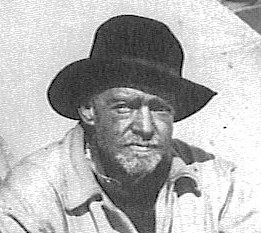 Ernest Shackleton after the loss of The Endurance
Ernest Shackleton after the loss of The Endurance
(photo: https://en.wikipedia.org/wiki/Ernest_Shackleton)
Sir Ernest Shackleton is best remembered as the leader of the ill-fated expedition to cross the Antarctic in 1914, and for the epic tale of bravery and endurance that he and his crew of 27 went through during the next two years to return to safety after losing their ship in the pack ice in 1915.
Shackleton was one of the world's greatest explorers. At the outbreak of war in August 1914, and with special permission of the King, Shackleton made his third trip to the Antarctic on his ship Endurance, with the aim to cross the continent via the South Pole.
The story of the expedition, and Shackleton’s leadership in the face of almost certain death, have since become the stuff of legend. Two books capture the extraordinary saga wonderfully: Leading at the Edge by Dennis Perkins explores the leadership lessons and The Endurance by Caroline Alexander contains a stirring account of the survival story with breath-taking photographs from the journey.
In January 1915, Shackleton and the crew came within 80 miles of their destination when the ship became trapped in the unseasonably thick ice. For the next ten months they waited for the ice to break.
It never did.
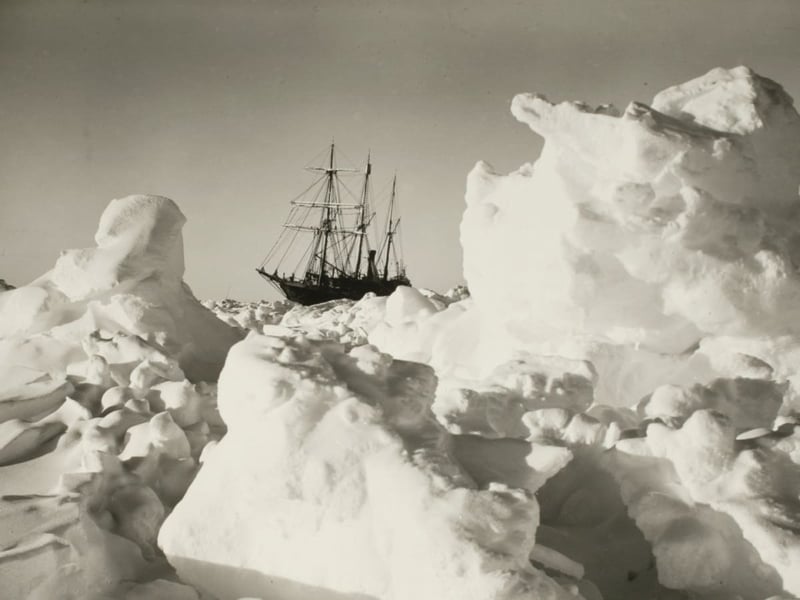 The Endurance trapped in pack ice, 1915
The Endurance trapped in pack ice, 1915
(photo: https://www.history.com/news/shackleton-endurance-survival)
Sadly, ‘The Endurance’ was crushed by the ice and sank. Shackleton’s crew had already abandoned the ship to live on the floating ice before deciding to walk across the continent and back to the water’s edge while pulling two of their small boats.
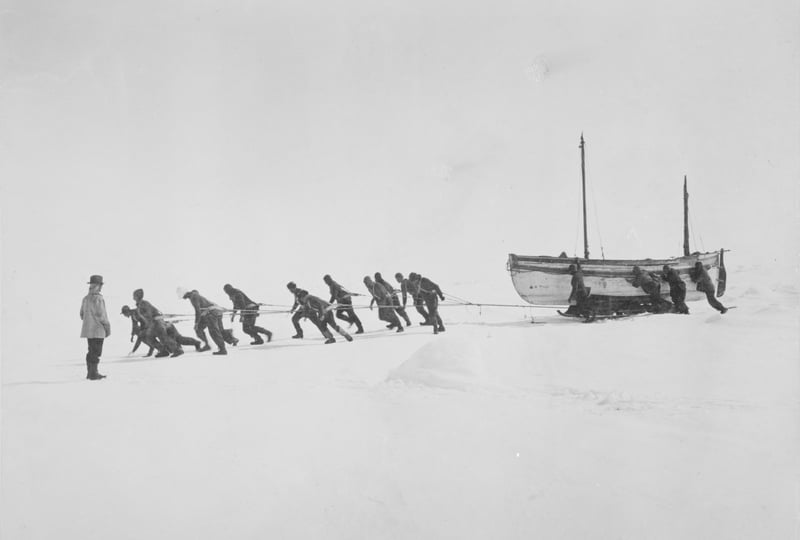 Hauling the James Caird Lifeboat over the ice in 1916
Hauling the James Caird Lifeboat over the ice in 1916
(photo: https://www.history.com/news/shackleton-endurance-survival)
Despite the problems of ice, cold and shortage of food and supplies, amazingly, they arrived at the open ocean. In April 1916, they set sail for and reached a narrow strip of shore on the uninhabited Elephant Island, almost 350 miles (550 kilometres) off the coast of Antarctica.
It was unlikely with their dwindling supplies and the weather worsening that they would be found as Elephant Island was nowhere near the usual shipping lanes. So, on April 24, 1916 Shackleton and five hand-picked crew members set off in the James Caird, a 23 foot lifeboat, on a near-impossible 800-mile journey to South Georgia, a journey one no-one had ever done before or since, across the world’s most treacherous sea in the heart of winter on a desperate rescue mission.
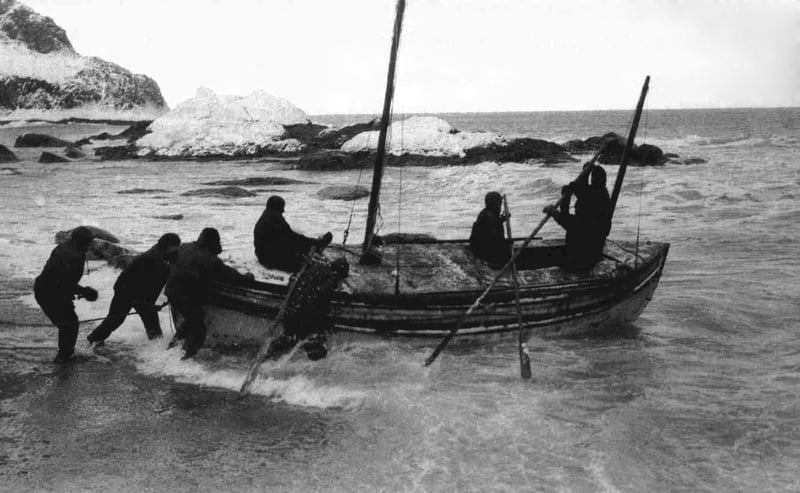 Launching the James Caird from Elephant Island on 24 April, 1916
Launching the James Caird from Elephant Island on 24 April, 1916
(photo: https://en.wikipedia.org/wiki/Ernest_Shackleton)
As soon as they were out in open water they had to contend with horrendous conditions. Shackleton later referred to 90-foot waves which should have overturned the boat.
It was not only mountainous waves that the men had to contend with. The boat was totally covered in ice which had to be chipped off. But even heavily gloved this was a nightmarish task because they were clinging on to the boat at the same time. There was also a dangerous amount of water getting in which they had to bail out for hours on end.
It was a miracle they survived and reached dry land. But despite having reached South Georgia, they quickly realised that they had landed on the wrong side of the island to the whaling stations. Shackleton decided against trying to make the 150-mile journey by sea. Instead, the men had to trek across the island, which meant tackling an un-mapped wilderness of mountainous cliffs, snowfields and glaciers – another journey no-one had ever made before.
Two of the crew were too ill to travel so Shackleton, along with his colleagues Frank Worsley and Tom Crean, made the grueling 10-day journey. They eventually reached the whaling station unrecognisable as the men who left two years before.
The challenge now was to try and return to Elephant Island as soon as possible as it was a race against time to rescue their stranded shipmates. All-in-all, Shackleton made four attempts. The first attempt was on a local whaling ship, but the pack ice barred their path 70 miles from Elephant Island and they were forced to head to the Falkland Islands.
Finally, at the fourth attempt on August 30 1916, Shackleton reached the 22 men who were alive, but exhausted and near starvation.
Shackleton had left his second-in-command, Frank Wild, in charge on Elephant Island. Wild is another of the heroes of this saga. Ever optimistic, each day he told the men, ‘Pack up lads, the boss may come today’ and of course the boss did finally come.
The story of this legendary expedition is rightly regarded as one of the greatest rescues in history and one that highlights Shackleton’s leadership wonderfully illustrated in the following saying:
“If you want scientific expertise then Robert Scott is the one for you.
If you want to speed across the terrain then Roald Amundsen is the one.
But if you find yourself in a big hole then get on your knees and pray for Shackleton, because he is the one to get you out of it.”
In the end it was his health, rather than his luck, that gave out, and it was during his fourth Antarctic trip in 1922 that Shackleton suffered a heart attack in Buenos Aires and later died on South Georgia. He was 47.
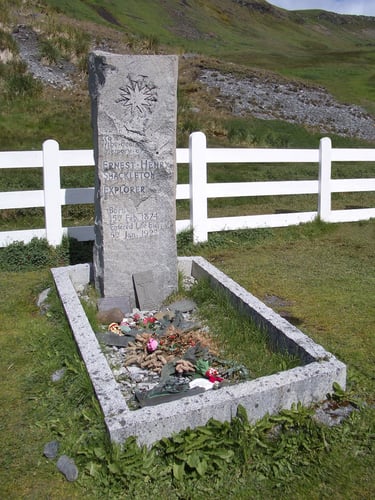 Shackleton’s grave, South Georgia
Shackleton’s grave, South Georgia
(photo: https://en.wikipedia.org/wiki/Ernest_Shackleton)
"Never for me the lowered banner,
never the last endeavour."
Sir Ernest Shackleton
Shackleton is widely regarded as one of the world’s greatest explorers. He is also someone whose leadership qualities and techniques are taught to business leaders on the QuoLux™ LEAD™ program.
As your thoughts start to turn to the new year, consider what leadership development you'd like to undertake, personally and for your team, for organisational development. Our next program for developing middle and junior managers (LEADlight) starts in March 2022, and our next effective leadership program (LEAD™) for senior leaders and managers starts after Easter in April 2022. To talk to one of our team about the programs and how they could benefit you and your organisation, please get in contact with Jo Draper here.
Don't miss out on reading our blog - sign up to it below to get it delivered to your inbox every Tuesday. Topics include leadership, management, strategy, leading change, leading teams, employee engagement, Good Dividends and many more.




